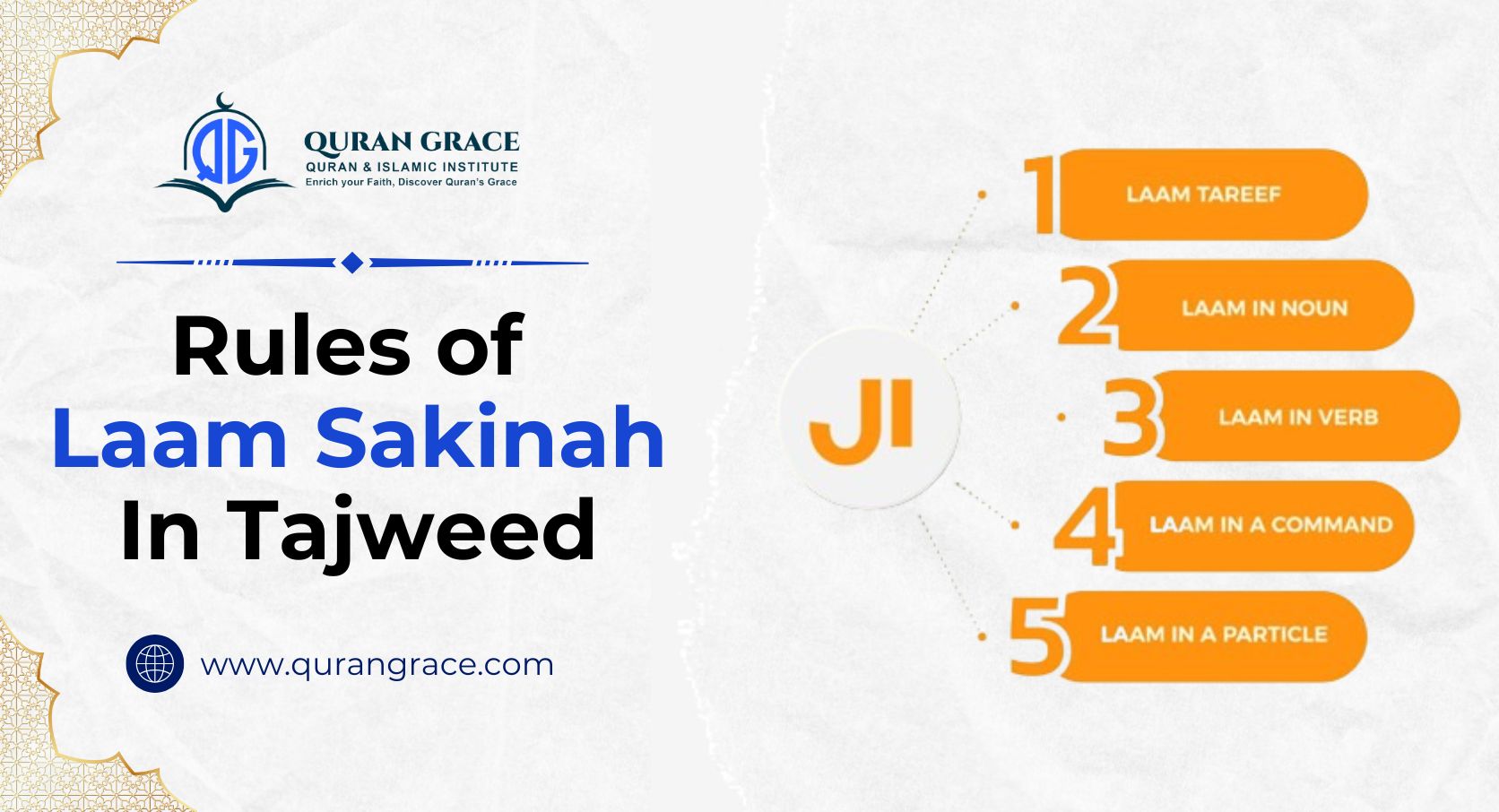Learning and practicing different Tajweed rules is essential for accurate reading and memorization of the Quran. One of the most important rules pertains to the letter “Laam Sakinah,” which changes its articulation depending on whether it appears in a noun, verb, or a standalone letter. In this discussion, we will explain the rules of Laam Sakinah thoroughly, using Quranic examples for clarity.
What is Laam Sakinah?
When the letter Laam (ل) is in a state of sukoon, it is termed Laam Sakinah. This condition occurs when the letter is tranquil, meaning it stands alone without any accompanying vowel or harakah such as dammah, kasrah, or fatha. The surrounding context, particularly the letters that precede or follow it, plays a crucial role in determining the pronunciation of Laam Sakinah.
The articulation of Laam Sakinah can vary significantly depending on its appearance in different grammatical structures, including nouns, verbs, and various sentence forms. Understanding these variations is essential for accurate reading and comprehension in the Arabic language.
Rules of Laam in Tajweed
There are 3 main rules of Laam Sakinah. Let’s explore each one of them in detail.
- Laam Al-Ism
- Laam Al-Fael
- Laam Al-Harf
The different pronunciation rules that Laam Sakinah follows in each of these domains will now be examined.
1. Laam Al-Ism (The Laam in Nouns)
Laam Al-Ism is the term for the Laam that appears in nouns. Similar to “the” in the English language. Laam mostly occurs in nouns as part of the definite article Al (ال). This Laam is called Laam At-Ta’reef (لام التعريف) because it makes a noun definite.
Rule of Laam Al-Ism: The type of letter that comes after Laam At-Ta’reef determines how it should be pronounced. There are 2 distinct categories of Laam At-Tareef (the definite Laam).
- Laam Shamsiyah (Sun Letters)
- Laam Qamariyah (Moon Letters)
1. Laam Al-Shamsiyah (Sun letters)
Shams is an Arabic word for sun. Laam At-Ta’reef is not pronounced when it is followed by a sun letter. Rather, a shaddah, which doubles the consonant sound, is used for pronouncing the next letter.
The examples of sun letters are: ت ث د ذ ر ز س ش ص ض ط ظ ل ن.
Example No 1: الشَّمْس Ash-Shams. The Laam is not pronounced in this instance since it is followed by the sun letter “ش“ (Sheen). The shaddah, on the other hand, doubles the sheen. You will not pronounce it as Al-Shams.
Example No 2: النَّاس An-Naas. Here, the Laam is followed by Noon (ن), another sun letter, and the Noon is doubled with shaddah. You will not pronounce it as Al-Naas.
Note: Quran Grace offers an advanced tajweed course specifically designed to teach laam sakinah rules with proficiency.
2. Laam Al-Qamariyah (Moon Laam)
Qamar in Arabic means moon. When the moon letters have Laam At-Ta’reef before them, they are pronounced clearly.
The moon letters are أ ب ج ح خ ع غ ف ق ك م و ه ي
Example No 1: الْقَمَر (Al-Qamar) We will say “Al-Qamar” and not Aq-Qamar. Since the letter “ق” (Qaaf) is a moon letter, the Laam is pronounced here. The following letter has no shaddah.
Example No 2: الْكِتَاب (Al-Kitaab) In this example, the Laam is pronounced because it is followed by Kaaf (ك), a moon letter. You will not pronounce it as Ak-Kitaab, but Al-Kitaab.
This distinction between Laam Al-Shamsiyah and Laam Al-Qamariyah is significant for Tajweed because it ensures that all letters are pronounced correctly and that the Quran is read carefully and clearly.
2. Laam Al-Fail (The Laam in Verbs)
The Laam that appears inside verbs is referred to as Laam Al-Fail. Similar to Laam Al-Ism, this laam can use sukoon in specific situations, such as when a verb requires conjugation or when specific forms of grammar are employed.
Rule of Laam Al-Fail:
It is important to always speak Laam Al-Fail clearly. However, the subsequent letters may cause a slight variation in its exact pronunciation.
Example 1: قُلْ (Qul) – “Say” [Surah Al-Ikhlas: 1]. The following letters do not alter the Laam in Qul, which is pronounced clearly with a sukoon.
Example 2: فَعَلْتُ (Fa’altu) – “I did” [Surah Al-A’raf: 12]. In this example, Laam appears in the verb past form and is pronounced clearly. Make sure you pronounce it as naturally as you can, without elongating it or shortening it.
3. Laam Al-Harf (The Laam in Particles and Prepositions)
Laam that occurs in particles or predicates is referred to as Laam Al-Harf. This can be found in Arabic in short functional words like Li (لِـ), which means “for” or “to.”
Rule of Laam Al-Harf:
Regardless of the following letter, the Laam in particles and statements is pronounced clearly.
Example 1: لِمَن (Li-man) – “For whom” [Surah Al-Mulk: 15].
The Laam in Li-man is pronounced clearly, regardless of the following letter Meem.
Example 2: لِلَّهِ (Lillaah) – “For Allah” [Surah Al-Baqarah: 29].
The Laam is pronounced clearly here, and the following Laam in Allah’s name follows its own unique rule, which we will discuss next.
Because these short words are used commonly in the Quran and because missing them might change a verse’s meaning or flow, it is important to learn how to pronounce Laam Al-Harf.
4. Special Case: Laam in Lafz al-Jalalah (The Name of Allah)
The Laam in Allah’s name (Lafz al-Jalalah) is treated as a separate case in Tajweed since it is essential and needs to be pronounced a certain way.
Rule of Laam in Lafz al-Jalalah:
The vowel that comes before Laam affects how it should be pronounced in Allah’s name:
- The Laam is pronounced with Tafkheem (a full, heavy sound) if the letter before it contains a Fatha ( َ ) or Dammah ( ُ ),
- Tarqeeq, a thinner, lighter sound, is used to pronounce the Laam if the previous letter has a Kasrah ( ِ ).
Example 1: تَالله (Tallaah) – “By Allah” [Surah Yusuf: 73].
The Laam is pronounced with Tafkheem because the preceding letter has a Fatha.
Example 2: بِالله (Billaah) – “In the name of Allah” [Surah Al-Baqarah: 112].
The Laam in this instance is pronounced with Tarqeeq because the preceding letter has a Kasrah.
It requires special attention because misinterpreting the Laam in Lafz al-Jalalah could alter the reverence and commitment that ought to be displayed when reciting Allah’s name.
Conclusion
The Laam Sakinah principles are essential in Tajweed because they preserve the Quran’s proper pronunciation and contribute to its linguistic beauty. In addition to the special rules for Lafz al-Jalalah, readers of the Quran must understand the distinctions between Laam Al-Ism, Laam Al-Fi’il, and Laam Al-Harf. You can also join the free trials of online tajweed classes at Quran Grace to master the rules of Tajweed efficiently.








